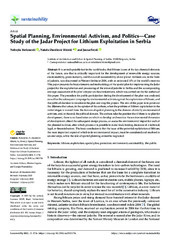Приказ основних података о документу
Spatial Planning, Environmental Activism, and Politics—Case Study of the Jadar Project for Lithium Exploitation in Serbia
| dc.creator | Stefanović, Nebojša | |
| dc.creator | Danilović Hristić, Nataša | |
| dc.creator | Petrić, Jasna | |
| dc.date.accessioned | 2023-01-26T11:18:03Z | |
| dc.date.available | 2023-01-26T11:18:03Z | |
| dc.date.issued | 2023 | |
| dc.identifier.issn | 2071-1050 | |
| dc.identifier.uri | http://raumplan.iaus.ac.rs/handle/123456789/715 | |
| dc.description.abstract | It is an indisputable fact in the world today that lithium is one of the key chemical elements of the future, one that is critically important for the development of renewable energy sources, electromobility, green industry, and the overall sustainability of our planet. Lithium ore, in the form of jadarite, was discovered in Western Serbia in 2004, with an estimated 10% of the world’s reserves. This paper presents the basic elements and methodology of the spatial plan for implementing the Jadar project for the exploitation and processing of the mineral jadarite in Serbia and the accompanying strategic assessment of the plan’s impact on the environment, which was carried out by the authors of this paper. The procedure for public participation during the development of the plan was analyzed, as well as the subsequent campaign by environmental activists against the exploitation of lithium, and the political decision to invalidate the plan and stop the project. The aim of the paper is to point out the dilemma that arises, in the opinion of the authors, when the problem of lithium exploitation in the initial stages is moved from the domain of spatial planning to the domain of strictly environmental activism, and, in the end, the political domain. The authors take the position that if there is no plan for development, there is no foundation on which to develop and monitor the environmental dimension of development, direct the subsequent design process, or assess the environmental impact for each of the planned facilities, after which process it is possible to make final, binding decisions of a technical, legal, or financial nature. The basic conclusion is that the issue of the potential exploitation of lithium, the most important aspect of which is its environmental impact, must be considered and resolved in several steps, while the role of spatial planning cannot be neglected. | sr |
| dc.language.iso | en | sr |
| dc.relation | info:eu-repo/grantAgreement/MESTD/inst-2020/200006/RS// | sr |
| dc.rights | openAccess | sr |
| dc.rights.uri | https://creativecommons.org/licenses/by/4.0/ | |
| dc.source | Sustainability | sr |
| dc.subject | lithium | sr |
| dc.subject | exploitation | sr |
| dc.subject | spatial plan | sr |
| dc.subject | protection | sr |
| dc.subject | environment | sr |
| dc.subject | sustainability | sr |
| dc.subject | the public | sr |
| dc.title | Spatial Planning, Environmental Activism, and Politics—Case Study of the Jadar Project for Lithium Exploitation in Serbia | sr |
| dc.type | article | sr |
| dc.rights.license | BY | sr |
| dc.citation.volume | 15 | |
| dc.citation.issue | 2 | |
| dc.citation.spage | 1736 | |
| dc.citation.rank | M22 | |
| dc.identifier.doi | https://doi.org/10.3390/su15021736 | |
| dc.identifier.fulltext | http://raumplan.iaus.ac.rs/bitstream/id/2969/sustainability-15-01736-v2.pdf | |
| dc.type.version | publishedVersion | sr |

